The web site as a whole gets a number of visitors and that number is growing, especially where I explain how I did something such as installing a deck or an off-grid solar power system. The search engines bring a lot of visitors to those pages. Not only do these articles describe what I did, but I also try to provide the kind of information that I was unable to find when I was researching the project. Each project utilizes certain tools and materials. For each of these I go to an online seller where I have already set up an 'affiliate' account, find the best deal on the item and plug it's ad into the relevant page next to the article.
The original water system
What Eileen used to refer to as 'camping', we could now call 'living'. It had almost become a real home. Almost; it was still lacking one essential ingredient: a shower.

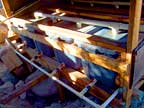
I knew that our current setup could not handle a shower. Our small tank-tub system was too low in elevation to provide enough water pressure for a shower. Now that we had power I could add a water pump to the system but a maximum load of 490 gallons just wasn't going to last too long. As it is we kept a number of gallon jugs at the ready inside the trailer to carry us while we waited a day or two for the $100 delivery. Plus, the water out of the old steel tank had to be run until it was clear because of the rust particles that would settle in the tank after it was filled, and the water from the 8 interconnected tubs still had a slight Rubbermaid flavor.
I had also come to discover that the PVC pipe that tied this all together and brought it to our faucets was just plain inadequate. The lengths that were exposed to the sun were slowly deteriorating, becoming I think more brittle. Some of that had even snapped off during a temporary freeze a few years before.
I think I also had something of a mental, or emotional, block against facing up to the obvious. That was not hard to do since up until now I had always had plenty of other urgent matters to think about, do and pay for, making such concerns kind of premature. I had put my heart and soul and a lot of effort over the years into putting that tank-tub system together. I did not even want to think about the enormity of what this predicament was trying to tell me. And hot water? Hah; don't even go there!
However, my wife had no problem thinking about it for me - and talking about it. No shower? No hot water? Don't even begin to think that that is somehow acceptable!!
It would mean abandoning the entire existing water system and starting from scratch. Obviously, it would require a lot of money, or credit, which I had already used on the new power system, etc., and was still paying off - but something had to be done; I knew that.
Finding room for a water tank

First I looked into what a decent - a very large - quality water tank would cost. My mindset was still stuck on the big beige steel tanks you see around the desert area and they would have been expensive, especially the transport and installation. I researched it. It turns out that the steel is becoming history; today's space age technology had brought in a new type of polyethylene, durable and flexible, one type formulated for above ground, another for below ground, one for water, another for chemicals, in almost any shape and appearance one could imagine, in almost any size from backpack portable to house sized humungous.
The best price I found online was $1764 including delivery and tax for a 3000 gallon polyethylene tank at
Loomis Tank Centers. However their rep, Mark Barlow, referred me to
The Cactus Mart, a local distributer 21 miles down the road. We drove on down there to take a look. The Cactus Mart had originally been, and still is, the Morongo Hardware, which has been there since the beginning of time, but had been expanded into a large garden center of pottery, vegetation, fish ponds, greenhouses and big trees - and a fascinating art gallery of paintings and sculpture. It is a nice place to wander through.
They had a large supply of small maybe 300 gallon tanks, some 2600 gallon tanks, and even one that was probably 6000 gallons or so. I took pictures of the 2600 gallon tank, took measurements and got a quote. That was on January 5.
Now my head was in gear. I went straight home and climbed the hill to as high an elevation as I could envision getting a tank. I went back and forth around and across the boulders looking for a good spot. I needed a spot, a 'pad', that could be leveled out enough to hold an eight foot wide tank, plus room to get around it. It wasn't until later that I realized I would also need room for a rock wall.
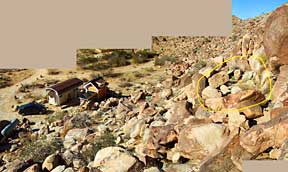
I wanted it convenient to the driveway where the water truck would back in, and convenient to our home. I needed to be able to stand at the prospective pad and envision where the pipes could be buried, a pipe from the driveway and another to the trailer, in as straight a line as possible.
Notice that there was a lot of envisioning going on. I really was not sure about how I was going to do anything and was going more by intuition than anything else. And yet I was preparing to do something that would probably remain in place pretty much forever - and it would have to come together into something that would have to work to fairly exacting specifications. Too low an elevation and the water pressure would be weak; any higher would have required a helicopter to get it up there. Too much left or right and the piping would have been excessively complex with twists and turns (elbows), each a potential leak and/or break if stressed.
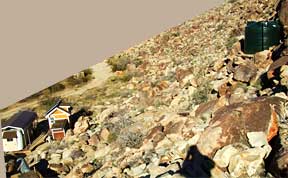
In the end I don't think there was any other spot that could have been as easily made into a pad because the large flattish rocks I needed were right there and the terrain, a mini arroyo, had already settled centuries ago into something of a partial pad. And it was in the right spot relative to the driveway and home below.
I wasn't thinking all that at the time; it kind of dawned on me after most of the job was done. So intuition works if one can learn to go with it. As I look at it now, about 2 months after completion and 3000 miles away, I cannot think of a better configuration, all things considered.
The new water system
By January 12, the pad was ready. Until then I really was not entirely decided. I wanted to be absolutely sure that I had a good level and solid place to put it before I committed to buying the tank, and therefore a water heater, plumbing and lumber. On January 12 I called The Cactus Mart and purchased the 2600 gallon tank for $1348, including tax and delivery, $416 less than the best price I had found online, though also 400 gallons less.
I have written 4 articles with pictures and animations depicting each stage of this project, and put links to them on
the 2008 Joshua Tree web site. They are there for you to explore as casually or as extensively as you like. They are:
As indicated above, with our existing water system we would generally run out of water suddenly, unexpectedly. It was nearly impossible to see down into the old steel tank to determine the water level; a stick dropped through the hole would just raise the rust particles that had settled. We generally used up the 240 gallons of tub water first, allowing the rust particles in the 250 gallon steel tank time to settle after a fill-up. Even with such a relatively small amount of water, it would generally last us the entire 5 +/- month visit, meaning 1 fill-up a year.
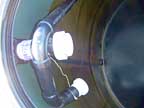
The bottom of the new 2600 gallon tank can be clearly seen through the manhole on top so we will know when it is near empty. Since the water truck can only deliver 2000 gallons at a time there is no advantage to waiting until the tank empties; when it gets below the 600 gallon mark I can make the call.
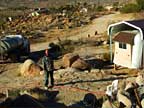
For this first water delivery I needed to install the filler pipe running from ground level up to the top of the tank. Then to be able to use the new water I had to install the supply pipe from the bottom of the tank down to ground level - and the new copper plumbing to our sink. The first pipe was completed on January 26, at which time I emailed the water guy and we received our first fill-up on January 29. The second pipe was connected on February 5, at which time we were able to use the new water. Until then we remained reliant on the old system. Well, the old system emptied out on January 24, 5 days before we received water in the new tank. We had to call for an emergency Saturday night fill-up of the old system and got only 12 days use out of it. That was frustrating, but it certainly put an exclamation mark on our need to replace the old system with something more workable.
I am quite pleased with a small invention of mine - a first flush water diverter. I was concerned about an accumulation of natural and toxic substances that would be inside the new filler pipe. I did not want it being dumped into my new tank; into my drinking water. When the pipe was originally glued together it would have accumulated some of the surrounding dirt, even though I usually capped the opposite end of each piece being cut and glued. It would have accumulated some of the black PVC cuttings. Also, I doubt these pipes were sterilized as they left the factory, and god knows what they would have picked up as they traveled the highways and byways to the local dealer, perhaps some E-coli from those who didn't wash, or some stray coughs of swine flu. Who knows? Think about it.
Then what about that glue? The Reader's Digest Handyman site says "The solvent vapors ... are dangerous to your health. Make sure you have plenty of ventilation or wear an approved organic vapor respirator ...". So what happens to those molecules of vapor as the cement cures inside the pipe? They will settle inside the pipe until, along with the sediment, cuttings and bugs, most will be flushed out with the first rush of water.
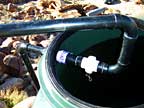
So it is that first flush that was playing on my mind in the days prior to delivery of the water. What I did was rig a 'C' shaped pipe that attaches to the filler inlet inside the top of the tank and throws the initial burst of water back out into the surrounding terrain, until I remove it. Problem solved. Of course after the tank is filled and the valve at the base of the filler pipe is closed and capped, the water that remains in that pipe will sit in there for maybe a year or more slowly soaking up additional chemicals, and providing a nice stagnant home for microorganisms to propagate, so the diverter will again be reattached with each filling of the tank.
The outlet pipe was likewise flushed when it was first turned on, as was the copper pipe system beneath our home during its initial activation.
I have been this way for a long time. Anything man-made is suspect, like household cleaners, medical inhalers, and new clothing, etc.. I always wash clothing before I wear them. If you have read
my account of cleaning and sanding the trailer in 2002, you may recall that I wore a filtered respirator throughout both processes. As my ex and I raised our daughters, we used
Shaklee and other biodegradable cleaning products. Now science is beginning to spread the message especially as the products also contribute to global warming. Recently I heard on the news that they are finding a correlation between the first introduction of man-made products to the market and a sharp rise in cancers, respiratory disease and other ailments. "A
study led by Mount Sinai School of Medicine ... found an average of 91 industrial compounds, pollutants, and other chemicals in the blood and urine of nine volunteers.".
Everything is right
While I was doing these projects I probably visited Home Depot, Barr Hardware and/or Wal-Mart on nearly a daily basis, getting supplies. They are all close by so I could just go get whatever I needed as I needed it, instead of stocking up on everything I might need ahead of time and then returning what I didn't use when the project was done. I do try to minimize these trips by listing what I will need and buying in bulk, but inevitably I still end up going back for individual items.
On February 14 I walked into Home Depot as usual, but what I saw front and center was a large display of flowers, with a sign stating what they were for and what you were supposed to do with them. Oh! Valentine's Day. I had totally forgotten. I immediately thanked the Gods and whatever brilliant person had set that display up, and bought a small rose plant. When I returned home, I presented this little gift to Eileen which slid me right into the 'Good loving and thoughtful husband who could do no wrong and really deserves the fringe benefits' category. Whew! She even had a card ready and waiting for me. Sometimes things just fall into place and work out the way they should. Nice!
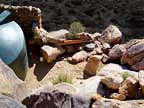

Another unexpected outcome of adding the water tank is a nice place to lean back with a cup of coffee and look over the valley, a magnificent sight. After laying the pipe and filling the trenches, I had then added rock steps over the outlet trench anywhere it seemed a bit steep.
The end result was that I could climb to the pad first thing in the morning with my coffee to enjoy the view, and again in the evening, without spilling a drop.
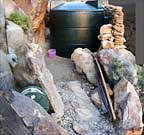
I have gradually cleared and leveled the pad area north of the tank, finding something that could almost be called a patio. It is not entirely done but I am thinking that it might be a nice place to set a patio table and chairs. In the early morning it is still in the hill's shadow and in the evening the sun is below the opposite ridge of the valley. What I am thinking is that during the heat of the day a sun shade screen mesh like they use to protect some crops could be raised above the pad providing additional shade for the water tank and the patio area. The main challenge here would to install some sort of unobtrusive anchor rings overhead that could hold up to the occasional power-gust that would try to scoop it up and throw it over the hill.
A self-sustaining web site
Over the years this web site has been comprised primarily of talk with pictures. However, if you take a look at the above mentioned articles and at some of the older stuff that I have begun to rework, you will see that something else has been added: advertisements that pertain to what the article is talking about. I would really like this web site to pay for itself. Someday it will be passed on to my daughters and descendants and I would like to think that it will continue its existence, perhaps forever. I'm sure they would value it enough to keep it going and add their own contributions, but it would be nice if it were self-sustaining. It would be especially nice if it went beyond that and produced a profit. Hence, the ads.
At the moment almost all of my ads go through Amazon.com because they make it relatively easy to do so, and because they sell an enormous variety of items. I also use Amazon because I know that the personal info is 100% safe.
So do me a favor. If you need anything, groceries, books, tools, whatever, click on one of my ads. Run a search for the item that you really want, buy it and you will have made a small contribution to the web site. I won't know who made the purchase but I will really appreciate it.
|
Copyright © 2009, Van Blakeman |